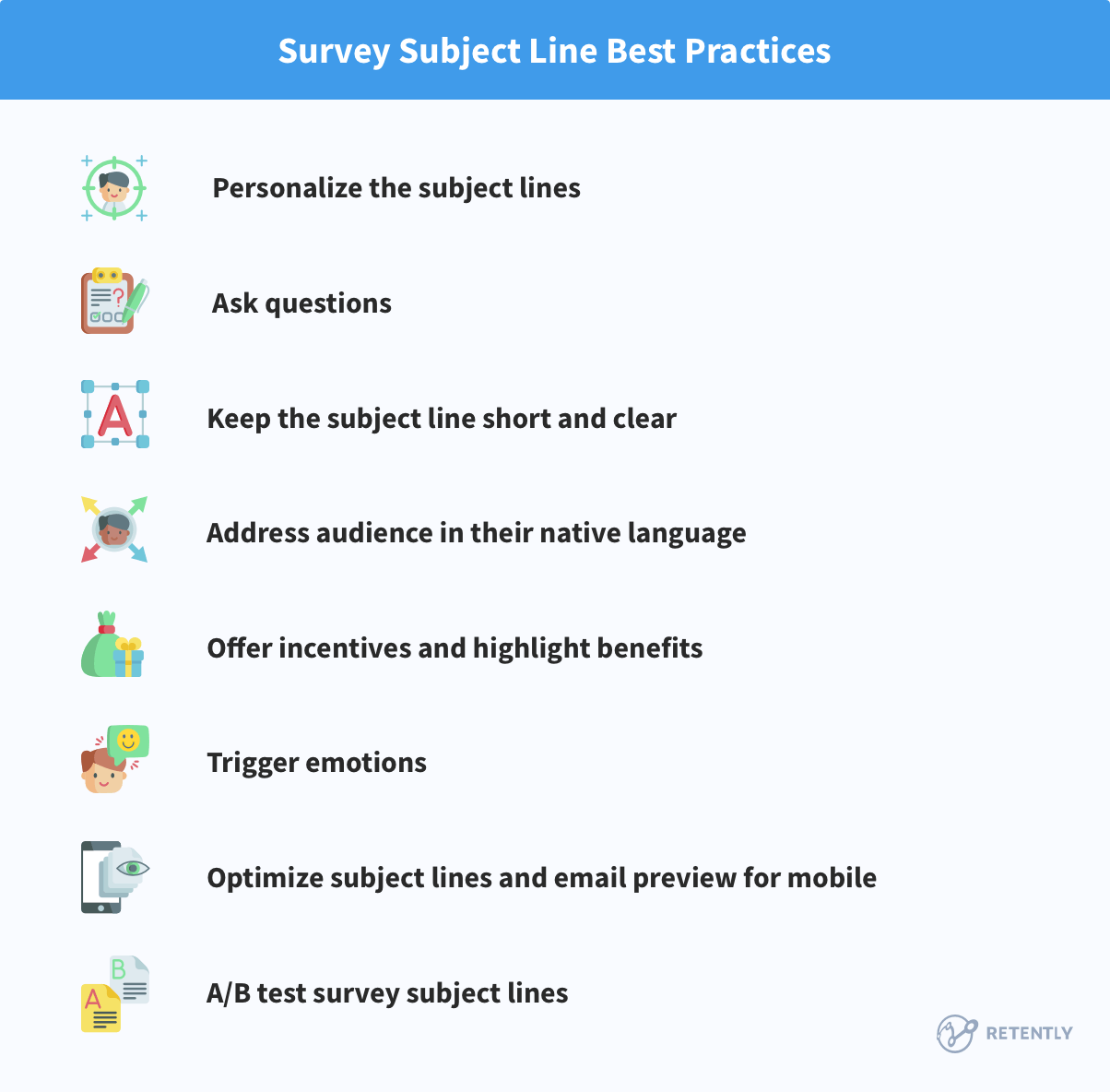When customers receive a survey by email, what’s the first thing they notice?
The survey question? The response options? The branding?
No, it’s actually the email subject line that determines whether or not they’ll find the message interesting or engaging and open it in the first place. Considering the survey fatigue and email overload, coming up with efficient subject lines that will get the door open is quite a challenge.
Bearing in mind its impact, we decided to come forth with the most actionable pointers on this topic, including the ones some of our clients stuck to when drafting their survey subject lines.

1. Personalize the subject line
When it comes to subject lines for survey emails, personalization is a must. According to data, personalizing the subject line can make people 22.2% more likely to open emails. Another study showed that personalized subject lines can offer a 37% increase in open rates and a 41% boost in survey response rates.
It’s not hard to see why. A subject line that doesn’t have a personal touch won’t feel as “human” to the recipient. It makes them feel like the sender doesn’t really value their opinions as they claim to. After all, they didn’t bother to put any effort into making sure the subject line was relevant enough to quickly get the recipient’s attention.
So, how can businesses make their survey subject lines more personalized? Some ideas include:
- Using the recipient’s first name – “[first name], how are you finding our service so far?”
- Using the recipient’s job title – “[first name], as [job title], how do you like our service?”
- Utilizing relevant time triggers – “Share your opinion about the purchase you made yesterday.”
- Leveraging location-based personalization – “[company name] asks: New York, how’s our brew?”
That kind of personalization can be done by means of custom properties included as survey variables anywhere in the survey template – like the ones Retently supports.
If you send a series of survey emails to the same respondent, make sure to change your approach to the survey subject lines. Relying only on survey variables would not do the job. Dig into customer feedback and behavior to figure out what could trigger their interest. Remember – your goal is to open the conversation.
However, navigate personalization with sensitivity. Always respect privacy by using the information willingly shared by the recipient and ensuring it’s contextually appropriate. While personal touches can enhance engagement, over-personalization risks being intrusive.
2. Ask questions
Ever received an email that instantly got you thinking? Questions have a magical way of doing just that. They engage curiosity and almost compel us to seek answers. When it comes to survey subject lines, posing a question can be a game-changer.
Many businesses use a simple statement as their subject line – like “Take our satisfaction survey”, for example. While it’s short and clear, some people might end up ignoring it simply because it feels more like a robot response than the start of an actual human conversation.
Using a question instead of a statement, like “How do you feel about our service?” – might get a better reaction from people just because it feels like the company is creating an instant dialogue with its customers. These questions not only hint at the content of the survey but also make recipients feel that their opinion is truly valued.
Businesses using personalization can make the question even more engaging and relevant. An email survey subject line like “[first name], how’s our product working out for you?” is much more likely to elicit a response than something like “Please rate our product”. The former gives the impression that the company actually cares about how the client has been using their service and what goals they’ve achieved with it.
Ideally, businesses should use open-ended questions (“Hi [first name] – What do you think about ACME?”) instead of Yes/No questions (“Would you like to rate our service?”), because it prevents respondents from inwardly answering the question with a quick “No”. Open-ended questions hand the control of the conversation to the responder, making them more open to engage and speak their mind on their terms.
Of course, questions are a good way of boosting engagement, but they must not be overused to serve their purpose.
3. Make the subject line clear
Data shows that clear subject lines get a much better response rate – around an increase of 366% according to the AWeber team’s case study, to be precise. That’s not hard to see why – the less confusing customers find the survey subject line, the more likely they’ll be to engage with it.
We actually have a few examples of unclear subject lines from our own research:
- “Would you refer ACME to another dealer?” – “Refer” can be confusing for some people, especially customers who don’t speak English as a first language. “Recommend” is much clearer.
- “ACME feedback” – The subject line feels confusing to read. “Feedback”, on its own, doesn’t make it clear what kind of input is required (Customer service feedback? Product/service feedback? Purchase feedback? etc.).
- “How are we doing?” – The wording is a bit vague, and the question can confuse the recipient. How is the brand doing in terms of offering good services, or how is the recipient feeling? The subject line is misleading and the recipient is confused about who the sender is and what kind of feedback they expect.
Businesses need to make sure their subject lines get the point across quickly and clearly. Vagueness, verbosity, and unfamiliar words (for example, “gratified” instead of “happy”) should be avoided, and the subject line should give clear, actionable directions.
“Hi [first name], how happy are you with our service?” is much clearer than “Hi [first name], are you satisfied?” or “Hi [first name], give us your input”, for example.
Also, it’s a good practice to mention the name of the service/product/brand customers are surveyed about. It offers a better response rate because it instantly informs recipients who the survey is coming from. For instance, “[first name], would you recommend Retently to your friends?” is more engaging than “[first name], would you recommend us to your friends?”
Especially since people tend to be over-surveyed, branding the subject line is a win-win tip, as it approaches the recipient with something they are already familiar with.
4. Optimize the survey subject line and preview for mobile
Long subject lines just don’t resonate well with people nowadays. Short attention spans don’t allow them to notice long subject lines. And, for some, reading a lengthy subject line can feel like a chore, so they’re less likely to click on it.
Plus, businesses should also consider that most email open rates come from mobile devices. Since in the US alone, 75% of people use their smartphones to check their inbox, your survey needs to look great on any device, starting with the subject line, the email preview, and ending with the length and number of questions preventing customers from dropping halfway.
It’s no secret long subject lines are truncated on mobile screens. But how long should the subject line then be? According to data, around 6 to 10 words will offer the most optimal open rate – 21%. In terms of characters, that’d be around 50 characters, give or take a few.
A good example of this would be using “[first name], how well did the Retently support team do?” instead of “Hello [first name], how would you rate your satisfaction with our customer support team?”.
Short and clear subject lines are what help you draw attention, while mobile-optimized and compelling email previews – what helps you engage to provide the best possible customer experience.
Yet, the trick isn’t to cut down the word count aimlessly but to ensure every word earns its place in your survey subject line for greater impact.
To efficiently deal with the screen size complexity and make your content user-friendly anytime and on any device, take advantage of the many available optimization software. Make sure you’re doing it right by, for example, running your email template through Google’s Mobile-Friendly Test to see how mobile responsive your sample is.
5. Address customers in their native language
You can spend days carefully crafting the perfect survey – addressing targeted questions to acquire valuable data, automating processes, and taking into account the lessons learned. But how much time and effort sink would it take if the survey does not consider your customers’ different demographics? To get people to actually respond to something you’ve put so much effort into, you have to ensure that your message is at least understood.
Addressing clients from different geographical areas in their native language when surveyed is a must. Adjust the subject line to get appropriate attention; translate the rating and the follow-up question to make it familiar and easy to interact with. The survey customization option will make this endeavor rather easy to handle.
Since your target is an increased response rate, consideration of such detail as language will repay the efforts. Keep in mind that once your business commits to an international audience, the touchpoints must be customized accordingly.
6. Offer incentives and highlight benefits
Imagine this: two emails in your inbox. One reads, “Take our survey!”, and the other says, “Get a 10% discount for sharing your thoughts!”. Which one catches your eye first? The answer is obvious.
Incentives can significantly boost survey response rates simply because they give people a clear reason to engage – they stand to win a prize. It’s pretty hard for a person to overlook a subject line that says they can get a nice discount or a free item, after all. It’s a part of human psychology one can’t ignore.
Yet, don’t promise what you can’t deliver. If you’re offering a 10% discount, mention it. If it’s a chance to win something, make it clear.
Some good survey subject lines that work in this case would be “Give us your feedback – Get a hat,” “Want to win sunglasses [first name]? Take our survey now,” and “Share your thoughts & get a 25% discount.”
While incentives are appealing, they shouldn’t overshadow the survey’s main objective. Instead of starting with the reward, consider mentioning it at the end. For example, a subject line like “Take our survey & unlock your discount!” seems to maintain this balance.
Adding a deadline combined with an incentive to emphasize a sense of scarcity might prompt the user to take the survey asap and not save it in their inbox for later – or even worse, disregard it at all.
Human beings are naturally wired to not want to miss out on things. That’s why limited-time deals or exclusive invites are so effective. This principle, termed FOMO (Fear of Missing Out), leverages the innate desire to be in the loop. Still, if every email is urgent, none of them are. Hence, you should implement these tactics rarely to maintain their effectiveness.
Using such words as “brief”, “short”, “two-question”, or “30-seconds” about the survey will also help out in terms of engagement. It will make it clear from the very beginning that not much of the customer’s time is required to earn the prize. But if you write it down – do mean it. Setting up an expectation for a short survey but overwhelming the customer with a complex questionnaire will backfire.
Check these survey subject line examples: “Take this brief survey now to get a 15% discount”, “Survey paired with compelling discounts – 24 hrs left”, “Take the ACME survey today and claim a 10% coupon”, “Your expertise today for a 20% off tomorrow. Is that a deal?”, “Exclusive survey for our top customers – You’re invited!”.
While this is an effective strategy, it does have two drawbacks.
Firstly, it only works for B2C companies. B2B businesses can’t really use incentives in the subject line. The only exception would be a B2B company with a small, high-ticket client base. In that case, subject lines like “Share your opinion and get a free month” would work.
Secondly, if businesses only use these types of subject lines, they can end up feeling spammy, and recipients might report them as such. Moreover, the wording of subject lines and specific word triggers may cause a message to be sent directly to the trash or spam folder by email servers, not even standing a chance to be opened by the recipient. So, crafting an effective survey subject line is as much about the words you use as the ones you should avoid. Striking a balance is essential.
However, if businesses can’t offer incentives, they need a survey subject line that focuses on a particular benefit the respondent stands to get.
“Help us help you,” “Enjoy a better experience – Help us improve our product” and “Help us offer you better results” are all good examples.
Such a subject line highlights just how important the recipient’s feedback will be, making clients feel more valued. Also, it won’t be perceived as a chore for a corporate entity since the line makes it clear it’s in their best interest to fill out the survey. Lastly, it might get a better response because it’s an emotional appeal, so it’s harder for the customer to ignore it.
7. Trigger emotions
The idea is that if a survey subject line doesn’t trigger an emotion, the email might not stand out from the dozens of other messages the recipient receives in his inbox.
For instance, a subject line like “Tell us what you think” will not likely make people feel anything in particular. Customers might ignore it simply because it’s too similar (in style and tone) to many other subject lines, and people will ignore it just because they are over-surveyed.
So what can businesses do? Well, especially for B2Cs, here are some emotions they could try triggering along with a subject line example for each one:
- Empathy – “Help us deliver better service” or “Shape [company name]’s future with your input”;
- Belonging/Friendship – “[first name], Welcome to the family! How was your purchase experience?” or “[first name], can you help a friend out?”;
- Feeling flattered – “[first name] – Your opinion matters. We want to hear your thoughts” or “We value your feedback – survey awaits”.
You may find different sources encouraging you to use emojis to drive engagement, trigger a positive sentiment, and make the survey subject lines stand out. It’s a rather obvious reaction one would expect; however, a study tends to contradict it. Although it draws more attention, it seems to work the other way around in terms of triggered emotions. An emoji used in the subject line increases the negative sentiment for an email by 26%.
8. A/B test the survey subject lines
So, what’s the most efficient of the tips? It’s hard to say. Obviously, combining all of these ideas to create email survey subject lines isn’t very efficient. The end result will just be a confusing mess that doesn’t resonate well.
Writing a survey subject line by the book is definitely good bait, but it will not necessarily land the fish. The key to an increased open and response rate lies in testing a variety of subject lines. Only by experimenting as a way to refine the subject lines, businesses can succeed in standing out from the hundreds of emails we all receive on a daily basis.
Create separate campaigns for specific survey subject lines, segment your audience, and analyze the results. Most of the NPS software will display the delivery stats for your surveys, making it rather simple to surface the templates that work best. However, do make sure that the analyzed survey sample meets the same conditions, as open rates and engagement do depend on a huge variety of factors (target audience, day of the week, time, demographics, etc.).
To get the most out of your surveys, look for something that doesn’t simply work, but that works best for your audience. A/B testing subject lines is a great idea since it allows brands to accurately compare open and response rates for different subject lines and come up with something that truly appeals to respondents.
Your subject lines are the ones that get that door opened, therefore make sure it’s the best it can be.
To sum it all up
The subject line can make or break a survey. If it’s not interesting or engaging enough, people will likely ignore the email, meaning companies will waste money on surveys that aren’t answered.
So, how can brands come up with the best subject lines for survey emails? What is a good subject line for a survey?
Well, personalization, keeping subject lines short and clear, and using questions (among other things) can definitely help. Of course, companies should do a lot of testing to see which type of survey subject line delivers the best response rate.
If you’re looking for a user-friendly scalable service that lets you send highly personalized surveys to segmented audiences and A/B test subject lines at the same time, give Retently a try.






























 Greg Raileanu
Greg Raileanu 



 Alex Bitca
Alex Bitca 

 Christina Sol
Christina Sol